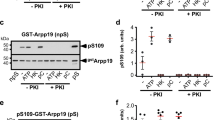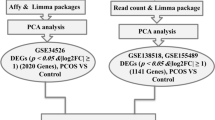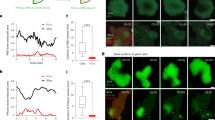Abstract
Xenopus oocytes are arrested in prophase of the first meiotic division. In response to progesterone, they re-enter meiosis and arrest again in metaphase of the second meiotic division. This process, called meiotic maturation, is under the control of the Cyclin B–Cdc2 complex, M phase promoting factor (MPF). Injection of a constitutively active Xenopus H-Ras protein activates MPF, suggesting that Ras proteins could be implicated in the progesterone transduction pathway. The aim of this study was (1) to elucidate the pathway triggered by H-Ras leading to MPF activation in Xenopus oocytes and (2) to investigate whether endogenous H-Ras is involved in the physiological process of meiotic maturation. We generated three constitutively active double mutants, each of them recruiting a single effector in mammalian cells, mitogen-activated protein kinase (MAPK), phosphatidylinositol 3-kinase (PI3K) or RalGDS. Our results show that the activation of a PI3K-related enzyme is crucial for H-Ras-induced MPF activation, whereas the recruitment of either MAPK or RalGDS is not. However, although the H-Ras/PI3K pathway is functional in Xenopus oocytes, it is not the physiological transducer of progesterone responsible for meiotic resumption.
This is a preview of subscription content, access via your institution
Access options
Subscribe to this journal
Receive 50 print issues and online access
$259.00 per year
only $5.18 per issue
Buy this article
- Purchase on SpringerLink
- Instant access to full article PDF
Prices may be subject to local taxes which are calculated during checkout








Similar content being viewed by others
References
Abrieu A, Fisher D, Simon MN, Doree M, Picard A . (1997). EMBO J 16: 6407–6413.
Andersen CB, Roth RA, Conti M . (1998). J Biol Chem 273: 18705–18708.
Anderson CW, Baum PR, Gesteland RF . (1973). J Virol 12: 241–252.
Bayaa M, Booth RA, Sheng Y, Johne Liu X . (2000). Proc Natl Acad Sci USA 97: 12607–12612.
Birchmeier C, Broek D, Wigler M . (1985). Cell 43: 615–621.
Bordier C . (1981). J Biol Chem 256: 1604–1607.
Castro A, Peter M, Lorca T, Mandart E . (2001). Biol Cell 93: 15–25.
De Smedt V, Poulhe R, Cayla X, Dessauge F, Karaiskou A, Jessus C et al. (2002). J Biol Chem 277: 28592–28600.
Dunphy WG, Kumagai A . (1991). Cell 67: 189–196.
Dupré A, Jessus C, Ozon R, Haccard O . (2002a). EMBO J 21: 4026–4036.
Dupré A, Suziedelis K, Valuckaite R, de Gunzburg J, Ozon R, Jessus C et al. (2002b). Oncogene 21: 6425–6433.
Fisher DL, Mandart E, Doree M . (2000). EMBO J 19: 1516–1524.
Frank-Vaillant M, Jessus C, Ozon R, Maller JL, Haccard O . (1999). Mol Biol Cell 10: 3279–3288.
Galaktionov K, Jessus C, Beach D . (1995). Genes Dev 9: 1046–1058.
Gautier J, Matsukawa T, Nurse P, Maller J . (1989). Nature 339: 626–629.
Gautier J, Minshull J, Lohka M, Glotzer M, Hunt T, Maller JL . (1990). Cell 60: 487–494.
Gautier J, Norbury C, Lohka M, Maller J . (1988). Cell 54: 433–439.
Gautier J, Solomon MJ, Booher RN, Bazan JF, Kirschner MW . (1991). Cell 67: 197–211.
Gross SD, Schwab MS, Taieb F, Lewellyn AL, Yue-Wei Q, Maller JL . (2000). Curr Biol 10: 430–438.
Haccard O, Jessus C . (2006). EMBO Rep 7: 321–325.
Haccard O, Lewellyn A, Hartley RS, Erikson E, Maller JL . (1995). Dev Biol 168: 677–682.
Higuchi R, Krummel B, Saiki RK . (1988). Nucleic Acids Res 16: 7351–7367.
Hiraoka D, Hori-Oshima S, Fukuhara T, Tachibana K, Okumura E, Kishimoto T . (2004). Dev Biol 276: 330–336.
Hochegger H, Klotzbucher A, Kirk J, Howell M, le Guellec K, Fletcher K et al. (2001). Development 128: 3795–3807.
Huang W, Kessler D, Erikson R . (1995). Mol Biol Cell 6: 237–245.
Jessus C, Rime H, Haccard O, Van Lint J, Goris J, Merlevede W et al. (1991). Development 111: 813–820.
Jessus C, Rime H, Ozon R . (1998). Biol Cell 90: 573–583.
Karaiskou A, Dupre A, Haccard O, Jessus C . (2001). Biol Cell 93: 35–46.
Karaiskou A, Jessus C, Brassac T, Ozon R . (1999). J Cell Sci 112: 3747–3756.
Kinashi T, Katagiri K, Watanabe S, Vanhaesebroeck B, Downward J, Takatsu K . (2000). J Biol Chem 275: 22590–22596.
Kobayashi H, Minshull J, Ford C, Golsteyn R, Poon R, Hunt T . (1991). J Cell Biol 114: 755–765.
Kumagai A, Dunphy WG . (1996). Science 273: 1377–1380.
Le Guellec R, Couturier A, Le Guellec K, Paris J, Le Fur N, Philippe M . (1991). Biol Cell 72: 39–45.
Lebreton S, Boissel L, Iouzalen N, Moreau J . (2004). Mech Dev 121: 1481–1494.
Liu XS, Ma C, Hamam A-W, Liu XJ . (2005a). Dev Biol 283: 180–190.
Liu Y, Shreder KR, Gai W, Corral S, Ferris DK, Rosenblum JS . (2005b). Chem Biol 12: 99–107.
Maller JL, Krebs EG . (1977). J Biol Chem 252: 1712–1718.
Muslin AJ, Macnicol AM, Williams LT . (1993). Mol Cell Biol 13: 4197–4202.
Pacold ME, Suire S, Perisic O, Lara-Gonzalez S, Davis CT, Walker EH et al. (2000). Cell 103: 931–943.
Perdiguero E, Nebreda AR . (2004). Cell Cycle 3: 733–737.
Peyssonnaux C, Provot S, Felder-Schmittbuhl MP, Calothy G, Eychene A . (2000). Mol Cell Biol 20: 7068–7079.
Prober DA, Edgar BA . (2002). Genes Dev 16: 2286–2299.
Reif K, Nobes CD, Thomas G, Hall A, Cantrell DA . (1996). Curr Biol 6: 1445–1455.
Rodriguez-Viciana P, Warne PH, Vanhaesebroeck B, Waterfield MD, Downward J . (1996). EMBO J 15: 2442–2451.
Sagata N, Daar I, Oskarsson M, Showalter SD, Vande Woude GF . (1989). Science 245: 643–646.
Sagata N, Oskarsson M, Copeland T, Brumbaugh J, Vande Woude GF . (1988). Nature 335: 519–525.
Stacey DW, Roudebush M, Day R, Mosser SD, Gibbs JB, Feig LA . (1991). Oncogene 6: 2297–2304.
Tian J, Kim S, Heilig E, Ruderman JV . (2000). Proc Natl Acad Sci USA 97: 14358–14363.
Urano T, Emkey R, Feig LA . (1996). EMBO J 15: 810–816.
Wang J, Liu XJ . (2004). J Cell Sci 117: 5107–5116.
White MA, Nicolette C, Minden A, Polverino A, Van Aelst L, Karin M et al. (1995). Cell 80: 533–541.
Zhu Y, Rice CD, Pang Y, Pace M, Thomas P . (2003). Proc Natl Acad Sci USA 100: 2231–2236.
Acknowledgements
We thank J Moreau for the Xenopus RalB clones, A Hall for the rCD2p110 construct, R Wolthuis, D Du Pasquier and all the members of the laboratory for precious advice, and especially R Ozon for critical reading of the manuscript. This work was supported by grants from CNRS, University Pierre and Marie Curie, ARC (no. 3571 to CJ) and Ligue Nationale contre le Cancer (Equipe labellisée 2003 to CJ).
Author information
Authors and Affiliations
Corresponding author
Rights and permissions
About this article
Cite this article
Gaffré, M., Dupré, A., Valuckaite, R. et al. Deciphering the H-Ras pathway in Xenopus oocyte. Oncogene 25, 5155–5162 (2006). https://doi.org/10.1038/sj.onc.1209523
Received:
Revised:
Accepted:
Published:
Issue date:
DOI: https://doi.org/10.1038/sj.onc.1209523



